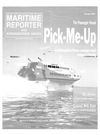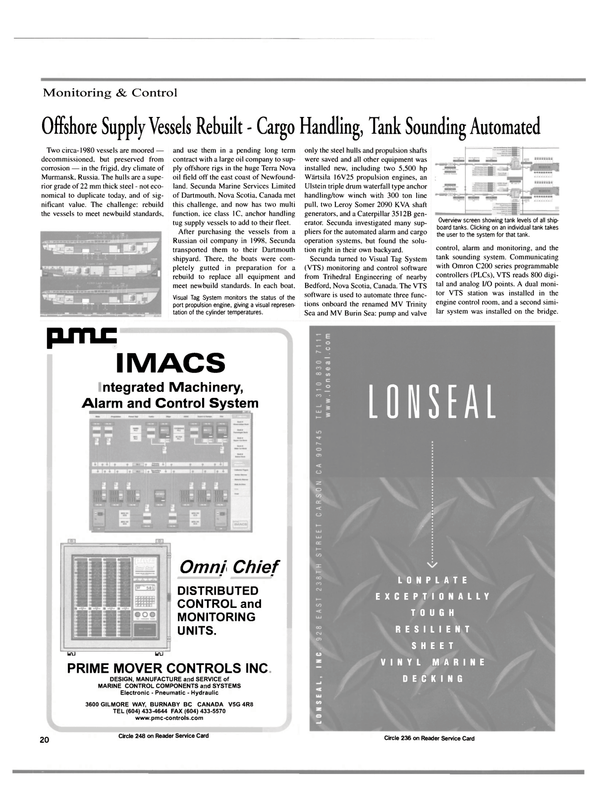
Offshore Supply Vessels Rebuilt - Cargo Handling, Tank Sounding Automated
Two circa-1980 vessels are moored — decommissioned, but preserved from corrosion — in the frigid, dry climate of Murmansk, Russia. The hulls are a superior grade of 22 mm thick steel - not economical to duplicate today, and of significant value. The challenge: rebuild the vessels to meet newbuild standards.
and use them in a pending long term contract with a large oil company to supply offshore rigs in the huge Terra Nova oil field off the east coast of Newfoundland.
Secunda Marine Services Limited of Dartmouth, Nova Scotia, Canada met this challenge, and now has two multi function, ice class 1C, anchor handling tug supply vessels to add to their fleet.
After purchasing the vessels from a Russian oil company in 1998, Secunda transported them to their Dartmouth shipyard. There, the boats were completely gutted in preparation for a rebuild to replace all equipment and meet newbuild standards. In each boat.
only the steel hulls and propulsion shafts were saved and all other equipment was installed new, including two 5,500 hp Wiirtsila 16V25 propulsion engines, an Ulstein triple drum waterfall type anchor handling/tow winch with 300 ton line pull, two Leroy Somer 2090 KVA shaft generators, and a Caterpillar 3512B generator.
Secunda investigated many suppliers for the automated alarm and cargo operation systems, but found the solution right in their own backyard.
Secunda turned to Visual Tag System (VTS) monitoring and control software from Trihedral Engineering of nearby Bedford, Nova Scotia, Canada. The VTS software is used to automate three functions onboard the renamed MV Trinity Sea and MV Burin Sea: pump and valve control, alarm and monitoring, and the tank sounding system. Communicating with Omron C200 series programmable controllers (PLCs), VTS reads 800 digital and analog I/O points. A dual monitor VTS station was installed in the engine control room, and a second similar system was installed on the bridge.
The pump and valve control system provides automated control of 112 valves, and remote start/stop of 14 cargo pumps that handle liquid cargo (such as potable water, liquid mud, drill water, mineral oil or brine). The alarm and monitoring system monitors the condition of the main engine, gearbox, shaft lines, thrusters, generators and bilges, generating an alarm when certain set points or thresholds are reached. Finally, the tank sounding system automatically measures the quantity of fluid in approximately 50 cargo tanks. According to Robert Field, Trihedral Control Systems Engineer on the project, "The pace and complexity of this project were a particular challenge. The system design was changing continually, but the flexibility of the software allowed us to accommodate the changes as we progressed through the rebuild, commissioning, and sea trial stages." With an overall length of 269.7 (82.2 m), breadth of 52.1 ft. (15.9 m) and draft of (20.3) 6.2 m, the MV Trinity Sea is currently working and the MV Burin Sea has completed sea trials, undergoing rigorous testing to meet Secunda's standards.
According to company sources, Secunda exceeded the expectations of their large oil company client by providing a fully automated system.
Circle 3 2 on Reader Service Card
Read Offshore Supply Vessels Rebuilt - Cargo Handling, Tank Sounding Automated in Pdf, Flash or Html5 edition of January 2000 Maritime Reporter
Other stories from January 2000 issue
Content
- Editor's Note page: 6
- A Manta in Dutch environs page: 8
- Good opening round for German contender page: 10
- Dutch small-ship prowess page: 10
- Holland America Contracts Fincantieri For Two page: 12
- Samsung Heavy Rings Up Significant Orders To Usher In New Year page: 13
- Totem Enters Into Agreement With NASSCO page: 14
- Perkins Sabre Launches Two New Engines page: 18
- Offshore Supply Vessels Rebuilt - Cargo Handling, Tank Sounding Automated page: 20
- Transas Launches Stand-Alone Engineroom Simulator page: 21
- VTC Expands Possibilities With Cutler-Hammer Agreement page: 21
- Columbia Coastal Christens Super Barge page: 22
- Pilot Boat Features New Hull Design page: 23
- Schlumberger Launches Deepwater Vessel page: 23
- Cascade Signs Maintenance/Repair Agreement page: 24
- Verolme Botlek Carries Out Vessel Upgrades page: 24
- Argent To Reactivate LNG Carrier page: 25
- United States Lines Flying High Again page: 26
- "Boutique" Cruise Vessel Keeps French Cruisers Nicely Coiffed page: 26
- SeaArk Marine's Atlantis Explorer page: 28
- HMS: Outfitting ferry for safety, success page: 29
- Passenger Vessel Report page: 30
- Austal To Start U.S. Shipbuilding Joint Venture page: 31
- Passenger Vessel Report page: 32
- Finnegan Joins Drew Marine page: 45
- The Coating Conundrum page: 46
- U.S. Builders Make Waves At Year End page: 51
- Alabama Launches ATB page: 52
- Deutz Augments Lower Power Range With New Engines page: 80
- Deere adds 8.1 L Engine to Line page: 80


